Due to reader requests, we’ve begun posting top-ten listings of various firearm categories that garner a lot of interest, such as 380 pistols for carry or other self defense. You can find all of those ranked articles on Gun-Tests.com by searching for the keyword “listicle.” A few months ago, we posted one of those best 380 ACP pistols lists, and we were informed by a reader and experienced shooter that his new Rock Island Armory Baby Rock did not live up to the promise of the pistol we tested nine years ago. Our pistol was delivered with a nice, crisp 4.5-pound trigger compression. That’s similar to one of the South Carolina test team’s Baby Rock, which has been in service for quite a few years as a backup to his 1911. That particular pistol features a trigger action breaking at 5.1 pounds. The reader measured the trigger action of his current production Baby Rock at more than 10 pounds. We corresponded with another reader who reported a 13.2-pound let off, and a third managed a 9.4-pound let off after considerable use and lubrication. Were these typical of current production? It would seem so, because the first reader contacted Armscor, intending to send the pistol in for adjustment. The company informed the reader that his Baby Rock was indeed in spec because there have been safety upgrades to the Baby Rock we tested and liked, and those safety enhancements included a heavier trigger. This gave us pause. What could have changed in the nine years since we tested the Baby Rock 380?
Another subject came up. The Glock 42 380 tested a few years ago was not as reliable as all other Glock pistols we’ve evaluated, giving us a number of short cycles and failures to lock open on the last shot in 2020, but only with heavier loaded ammunition. A rater who uses his Glock in daily carry noted that this was true initially, but new magazines and a slight redesign helped his gun to reach 1,000 rounds so far without any malfunction, and very little cleaning, he added. We decided to obtain a new-production Rock Island Baby Rock 380 ACP and Glock Model 42 to see if their current performance was the same, or better, or worse than the previous generations tested nine and five years ago, respectively.
Since we tested the Smith & Wesson EZ Rack pistol more recently in May 2024, we upgraded to a Performance Center pistol of the same type, but with improvements, in this installment. The standard S&W EZ Rack was overall satisfactory, but had experienced some problems with a certain type of ammunition. A tester familiar with both the EZ Rack and the ammunition brand felt that it wasn’t the gun at fault. This revisit is intended to qualify or isolate these problems and fixes.
Rock Island Armory M1911A Baby Rock 51912 380 ACP
$350
Gun Tests grade: C
It wasn’t surprising that changing a single specification, the trigger action, resulted in such inferior performance. The Baby Rock is reliable, and we are certain intrinsic accuracy is still good, but practical accuracy is poor.
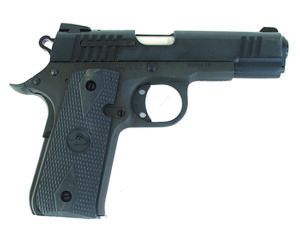
| Action | Semi-auto, single action blowback |
|---|---|
| Overall Length | 6.6 in. |
| Overall Height | 4.6 in. |
| Maximum Width | 1.1 in. |
| Weight Unloaded | 22.0 oz. |
| Weight Loaded | 24.1 oz. |
| Barrel Length | 3.75 in. |
| Magazine | 7-round detachable box |
| Magazine Price | $29 |
| Slide | Dark-matte steel |
| Slide Retraction Effort | 13.5 lbs. |
| Frame | Dark-matte steel |
| Frame Front Strap Height | 2.3 in. |
| Frame Rear Strap Height | 2.8 in. |
| Grips | Checkered hard-black rubber |
| Grip Thickness Maximum | 1.1 in. |
| Grip Circumference Maximum | 5.6 in. |
| Front Sight | Serrated front blade |
| Rear Sight | LoMount type |
| Trigger Pull Weight Single Action | 10.1 lbs. |
| Trigger Span Single Action | 2.25 in. |
| Safeties | Slide lock, grip |
| Warranty | Limited lifetime |
| Telephone | (775) 537 1444 |
| Website | Armscor.com |
We must note that the Rock Island pistol is actually more affordable today, with an average price $6 less than nine years ago. Considering the inflation we have lived with for some time, that is worth writing home about. The Rock Island Armory pistol is finished in a dull matte black that seems durable enough. The pistol is styled more like a 1911 than most small pistols, such as the SIG 238 and Springfield 911. Those handguns do not have a grip safety and may be placed on Safe with the hammer down. They are more like the old Star-type pistols than a true 1911. The Baby Rock features a grip safety and a standard slide-lock safety. As such, it is similar to the vintage Llama type. The pistol may be carried cocked and locked or hammer down on a loaded chamber. The pistol features a grip safety, slide-lock safety, single-action trigger, and takedown familiar to any 1911 fan. However, unlike most 1911 handguns, the Baby Rock may be placed on Safe with the hammer at half cock in Browning Hi-Power style. We don’t see an advantage, but there it is.
The slide features forward cocking serrations. They are well cut and easily grasped, offering good leverage. The sights are good examples of a modified low-mount semi-Novak type, with the front sight using a combination set screw and staked in system. The rear sight is drift adjustable. Thankfully, the sights were properly regulated for 15-yard shooting with 95-grain FMJ ammunition. A departure from the 1911 template is an external extractor. The hammer is a rowel/Commander type. Unlike most 1911-like 380 ACP pistols, the Baby Rock takes down like a true 1911. Remove the magazine and double check the chamber is clear. Put the slide-lock safety in place and rotate the barrel bushing as you depress the recoil-spring plunger. Release the slide-lock safety and slip the slide slightly to the rear as you press the slide lock out. Run the slide forward off the frame. Remove the recoil spring and guide rod. Twist the barrel bushing to release the barrel. Remove the barrel from the front of the slide. While this is the most complicated disassembly of the three pistols, it is straightforward 1911 handling. The pistol doesn’t feature a swinging link because it is a blowback-type handgun, but it instead features an angled camming surface at the bottom of the barrel.
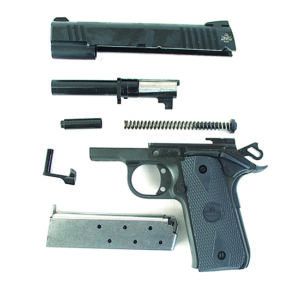
The frame has a smooth front strap, while the mainspring housing is serrated. The grips are checkered rubber and work well in maintaining control of the handgun. The slide-lock safety of the original pistol was stiff; this one is properly set with a sharp indent. It is stiffer than most 1911 handguns, requiring more effort than the Smith & Wesson EZ Rack safety. The grip safety is properly set, allowing the trigger to be pressed as the grip safety is about halfway in its travel. The hammer is easily cocked with a strong but not excessive mainspring. The magazine release is positive in operation. The magazine does not drop free but must be pulled from the magazine well. A grip screw was too long and was dragging on the magazine, so we removed the screw and shortened it. It would have worked okay simply by loosening the screw. The single magazine supplied is a stainless-steel Metalform, a well-made magazine from a respected maker.
What we didn’t like was the trigger action. We could not test the trigger-pull weight with our manual Wheeler or RCBS trigger gauges because they would not register the heavy weight needed. One of the raters dug out a Lyman digital gauge, and we read a disappointing 11.43 pounds.
Next, we cleaned the action using a spray degreaser. We have sometimes found that clearing grease from the action results in a cleaner trigger movement. One of the raters also took time to hold the hammer by thumb pressure while pressing the trigger, not allowing the hammer to drop. This sometimes clears burrs away and results in a better action. After these efforts, the Baby Rock registered 10.5 pounds. Too heavy, but at least it was consistent.
Unlike the other pistols, the Baby Rock is not supplied with a spare magazine. With a spare magazine added to the cost, the pistol is closer to the Glock 42 in price. It is inconvenient running firing tests with a single magazine. We loaded the steel magazine for the firing test, and conducted combat shooting first with Fiocchi FMJ ammunition. We fired 50 rounds in each pistol and also fired six rounds in each gun of the stout Buffalo Bore 90-grain JHP. This load had given short cycles in the Glock 42 previously tested, but there were no issues this time.
The pistol is fast from concealed carry and fast on target. The sights are good for combat shooting. Firing at 7 to 10 yards, we were able to get fair hits on intruder-outline targets. The trigger action, however, was so heavy and stiff that it resulted in a good number of shots outside the X-ring, even at 7 yards. Reset was rapid, typical in 1911 fashion, but this wasn’t enough to provide good results compared to the 4.5-pound trigger of the Smith & Wesson and 6.0-pound trigger of the Glock. The trigger-pull weight of this Glock, interestingly enough, was within 0.1 pound of the earlier example tested, while the Smith & Wesson Performance Center gun was actually 0.1 pound heavier than the standard model previously tested. The Baby Rock was much less accurate in rapid fire than the other two handguns. If we slowed down to control the trigger press, the pistol made a bit tighter group, but was much slower in addressing the targets. There were no failures to feed, chamber, fire, or eject.
Moving to benchrest accuracy, we used three loads, Federal’s 85-grain Punch, Remington 88-grain JHPs, and Hornady American Gunner 90-grain XTPs. We fired five-shot groups for accuracy. The original Baby Rock exhibited groups of 2 to 3.6 inches, with a respectable average at 15 yards. We felt this was very good for this size pistol. In this case, group size was considerably larger. The only obvious difference was the heavy trigger action. Most groups were well over 3 inches, and some were more than 4 inches. This was a disappointment. Intrinsic accuracy is the basic mechanical accuracy of a firearm, while practical accuracy is how well you may fire the handgun. The Baby Rock is probably as intrinsically accurate as the earlier gun, but the heavy trigger action limits its practical accuracy. There were no failures to feed, chamber, fire, or eject during the test.
Our Team Said: We rated the pistol down a full grade on the heavy trigger action and another on accuracy. Also, the Baby Rock is not left-hand friendly like the other pistols. We would not buy this gun as tested.
| 380 ACP RANGE DATA | |||
|---|---|---|---|
| Federal Punch 85-grain JHP PD380P1 | Glock Model 42 | Rock Island Armory Baby Rock | Smith & Wesson EZ Rack |
| Average Velocity | 930 fps | 939 fps | 960 fps |
| Muzzle Energy | 163 ft.-lbs. | 166 ft.-lbs. | 174 ft.-lbs. |
| Small Group | 2.6 in. | 2.5 in. | 1.8 in. |
| Average Group | 3.25 in. | 3.5 in. | 2.4 in. |
| Remington UMC 88-grain JHP L380R1B | Glock Model 42 | Rock Island Armory Baby Rock | Smith & Wesson EZ Rack |
| Average Velocity | 877 fps | 901 fps | 920 fps |
| Muzzle Energy | 150 ft.-lbs. | 159 ft.-lbs. | 165 ft.-lbs. |
| Small Group | 2.25 in. | 3.65 in. | 2.0 in. |
| Average Group | 2.7 in. | 4.2 in. | 2.4 in. |
| Hornady American Gunner 90-grain XTP 90104 | Glock Model 42 | Rock Island Armory Baby Rock | Smith & Wesson EZ Rack |
| Average Velocity | 884 fps | 899 fps | 890 fps |
| Muzzle Energy | 156 ft.-lbs. | 161 ft.-lbs. | 158 ft.-lbs. |
| Small Group | 2.5 in. | 3.5 in. | 1.5 in. |
| Average Group | 3.25 in. | 4.0 in. | 2.0 in. |
We fired groups at 15 yards from a bench using an MTM Case-Gard K-Zone Pistol Rest. We measured velocities with a Competition Electronics Pro Chrony. The first screen of the chronograph was 10 feet from the muzzles. JHP = jacketed hollow point. XTP = eXtreme Terminal Performance jacketed hollow point.
Written and photographed by Bob Campbell, using evaluations from Gun Tests Team members. GT



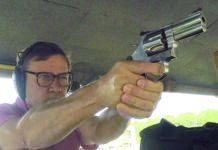
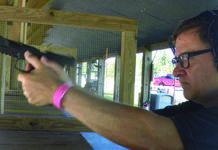
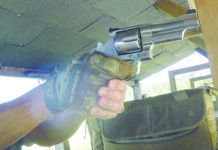
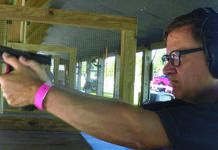
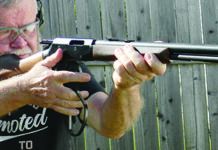
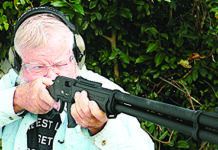
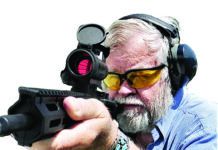
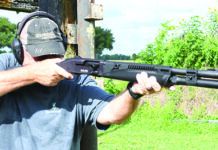
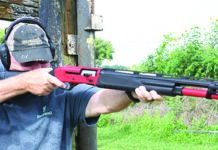
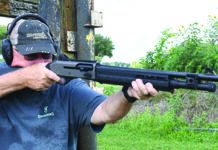
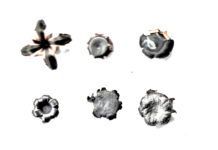
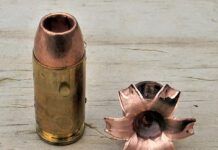

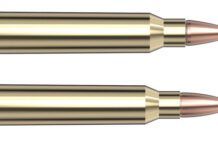
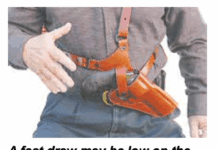
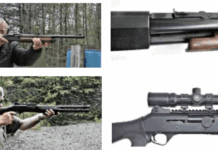
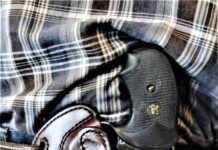


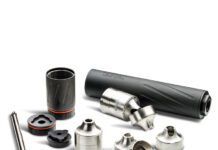
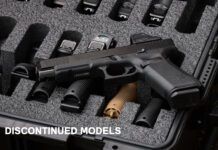

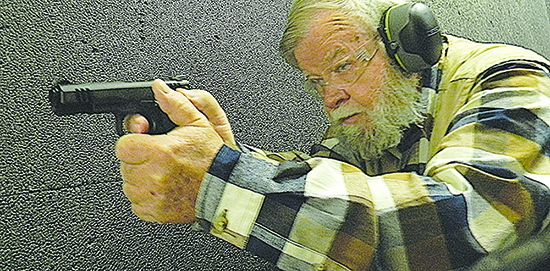

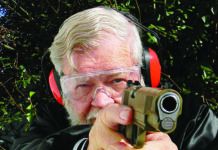

When I bought my Baby Rock the slide could not be locked back, I let Rock Island know and they sent me a replacement part that was exactly the same part that was already in the pistol. After some back and forth I sent the pistol in to Rock Island and in a reasonable amount of time they sent it back to me with a note that they had “made changes” and that it now functioned “perfectly.” But of course it does not, the slide can be manually locked back but it will not lock back after the last round. I will not carry a pistol that will not reliably lock back on an empty magazine. It is a beautiful pistol, fits great in my hand and in a wallet style pocket holster, but it is a huge disappointment.